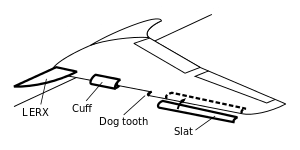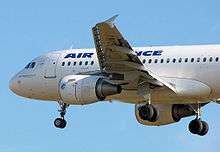Leading-edge extension

A leading-edge extension is a device installed on or in the leading edge of an aircraft wing. The primary reason for adding such devices is to increase lift at high angles of attack and low airspeeds. This improves handling and response, lowers takeoff and landing speeds, and increases the performance and safety of the aircraft during takeoff and landing. A dog tooth can also improve airflow and reduce drag at higher speeds.
Leading-edge slat

A Leading edge slat is an aerodynamic surface running spanwise just ahead of the wing leading edge. It creates a leading edge slot between the slat and wing which directs air over the wing surface, helping to maintain smooth airflow at low speeds and high angles of attack. This delays the stall, allowing the aircraft to fly at a higher angle of attack. Slats may be made fixed, or retractable in normal flight to minimize drag.
Dogtooth extension

A dogtooth is a small, sharp zig-zag break in the leading edge of a wing. It is usually used on a swept wing, to generate a vortex flow field to prevent separated flow from progressing outboard at high angle of attack.[1] The effect is the same as a wing fence.[2] It can also be used on straight wings in a Drooped Leading Edge arrangement.
Where the dogtooth is added as an afterthought, as for example on the Hawker Hunter and some variants of the Quest Kodiak, the dogtooth is created by adding an extension to the outer section of the leading edge.
Leading-edge cuff
A Leading edge cuff (or wing cuff) is a fixed aerodynamic device employed on fixed-wing aircraft to introduce a sharp discontinuity in the leading edge of the wing in the same way as a dogtooth. It also typically has a slightly drooped leading edge to improve low-speed characteristics.
Leading-edge root extension

A leading-edge root extension (LERX) is a small fillet, typically roughly triangular in shape, running forward from the leading edge of the wing root to a point along the fuselage. These are often called simply leading-edge extensions (LEX), although they are not the only kind. To avoid ambiguity, this article uses the term LERX.
On a modern fighter aircraft LERX induce controlled airflow over the wing at high angles of attack, so delaying the stall and consequent loss of lift. In cruising flight the effect of the LERX is minimal. However at high angles of attack, as often encountered in a dog fight or during takeoff and landing, the LERX generates a high-speed vortex that attaches to the top of the wing. The vortex action maintains a smooth airflow over the wing surface well past the normal stall point at which the airflow would otherwise break up, thus sustaining lift at very high angles.
LERX were first used on the Northrop F-5 "Freedom fighter" which flew in 1959,[3] and have since become commonplace on many combat aircraft. The F/A-18 Hornet has especially large examples, as does the Sukhoi Su-27 and the CAC/PAC JF-17 Thunder. The Su-27 LERX help make some advanced maneuvers possible, such as the Pugachev's Cobra, the Cobra Turn and the Kulbit.
A long, narrow sideways extension to the fuselage, attached in this position, is an example of a chine.
See also
| Wikimedia Commons has media related to Leading-edge devices. |
References
- ↑ Effects of Wing-Leading-Edge Modifications on a Full-Scale, Low-Wing General Aviation Airplane, Nasa TP 2011
- ↑ A Two-seat Gnat Development for the R.A.F. Flight 1959
- ↑ Green, W. and Swanborough, G.; The complete book of fighters, Salamander, 1994